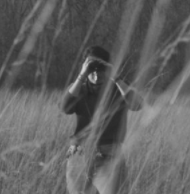At well pads—areas developed for oil and gas drilling—both the vegetation and topsoil are completely removed. After drilling infrastructure is installed, these areas are reclaimed, meaning the topsoil is then replaced, and the areas are seeded with various mixes of species. Despite reclamation efforts, big sagebrush communities have an extremely hard time returning to a stable state. Damaris’s research focuses on the recovery of big sagebrush communities to these disturbed areas. During this fellowship, she will collect data to describe the community composition and soil characteristics at well pads to use as inputs to a simulation model. The results of simulations will elucidate aspects of the timescale and mechanisms associated with recovery, and thus have implications for big sagebrush restoration in disturbed areas.
STUDENT RESEARCHER

Damaris Chenoweth, Western Resources Fellow and Research Assistant | Damaris is a Master of Environmental Science candidate at Yale School of the Environment. Her thesis research focuses on modeling sagebrush community regeneration in areas disturbed by oil and gas extraction. At Ucross, Damaris assesses the vulnerability of conservation targets to climate change in a region known as The Crown of the Continent. For this project, she works closely with US Fish and Wildlife to contribute to a larger Landscape Conservation Design. Blog
